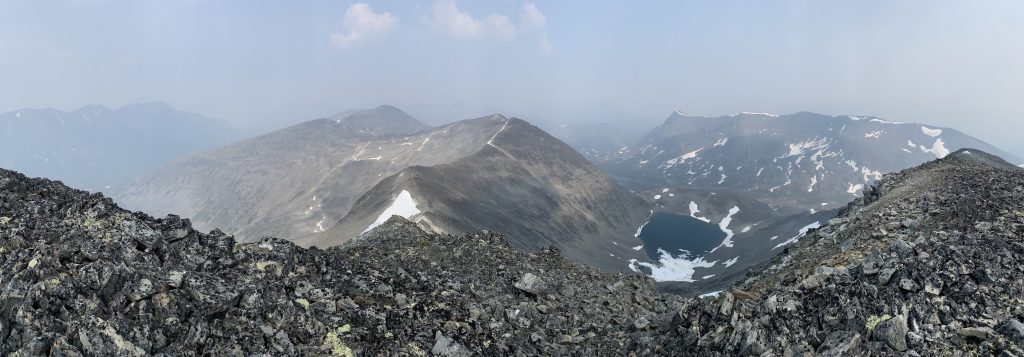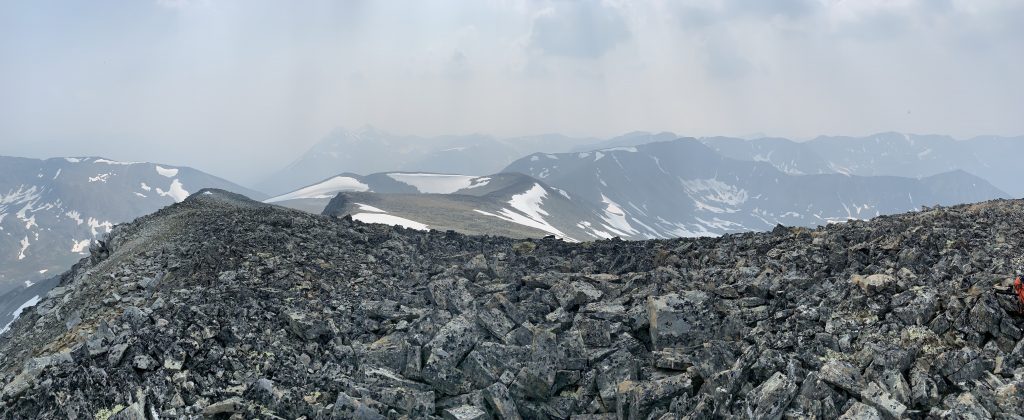Binarism is dying. Thank God, the gods, and no-god. We are entering an era of trans non-conformity that transcends binary opposites. I welcome it, as should everyone else. Binarism is a spiritual and psychological affliction that has wrought destruction not only in the non-physical realms of spirituality and psychology, but in the physical world as well.
Male and female are not opposites; they’re complementary. Yin and yang, in balance, form the cosmic whole. Healthy males are in touch with yin, just as healthy females are in touch with yang.
Our planet has north and south poles, but they also are not opposites. The magnetic poles shift independently due to movement of molten iron within the Earth’s core. They are also very much connected by the spherical nature of our planet.
Our society is both capitalistic and socialistic. Capitalism and socialism (in basically all modern nations) are not opposites, but complementary elements of mixed-economies. For instance, the roads you drive on are a public enterprise: an example of socialism. The cars manufactured to drive on those roads are a private enterprise: an example of capitalism. The public education system through which most of us were educated and socialized is another example of socialism (a public enterprise), but the physical components of schools themselves are generally examples of capitalism (private enterprises manufacture the construction materials, computers, calculators, etc. that make our educational experience what it is).
Our clinging to binarism, currently in its death throes, is threatening the balance that life depends on. Society is out of whack: in favor of economy to the detriment of ecology and profit to the detriment of people. Our politics are now perhaps more polarized than ever.
You could accuse me of guilt in this regard. If you’ve read these trips reports before, perhaps you’ve identified me as a far-out, leftist radical. Perhaps, admittedly, I am.
But, really, I’m trans-political: beyond, or non-conforming, to left and right. Idealistically, I’m an anarchist. Not an anarchist in the since of anything-goes chaos, but an anarchist in the sophisticated sense that the ideal state of existence is beyond hierarchy: no power of one over another. But, reaching that ideal state requires humans that are autonomously and responsibly self-governing and do not need external authority to regulate their peaceful and harmonious affairs with one another, other forms of life, and the planet itself.
We are not there yet. In order to get humanity to the state where individuals can be autonomously self-governing (without the need for external authority), individuals need to be spiritually, psychologically, intellectually, and emotionally evolved and enlightened to a very high level. To reach that level, the highest quality education and socialization are necessary. Providing that high level of education and socialization is primarily a public, socialistic enterprise. That is why, realistically, I’m a socialist. Given how far our society has swung to the right, in favor of private enterprise and capitalism, I’m acting as a far-out leftist radical in order to help restore balance.
In regard to education, socialization, and socialism; I give much credit to the American public school system for evolving our society towards racial equality. While racism in American is alive and well today, and white racists have in recent years been emboldened by a disgraceful president (really, they’ve all been disgraceful), racism is not generally acceptable.
It was just 65 years ago that Emmett Till, a 14 year old African American boy, was brutally beaten and killed by racist white thugs in a grotesque act of terror for just whistling at a white woman he thought was pretty. The racist, white terrorists responsible for his torture and murder were acquitted by an all-white, all-male jury.
As congresswoman Karen Bass recently stated about American lynching culture in the former confederate states: “A 1930 editorial in the Raleigh News & Observer noted the elation of the audience witnessing a lynching as follows: ‘Girls giggled as the flies fed on the blood that dripped from the Negro’s nose.’ Lynchings were brutal, violent and savage public spectacles. As I said, they were advertised in newspapers, and postcards were sold. Souvenirs were made from victims’ remains.” Many racist white Americans were as brutal, indecent, disgusting, and savage as their racist white counterparts in Germany: the Nazis.
Really, perhaps racist white Americans were worse than the racist white Germans known as the Nazis? Speaking of “savages,” the Nazi genocide of European Jews was nowhere near as “successful” as the European American genocide of American Indians. What’s worse? While the Nazi genocide of European Jews is widely recognized and accepted as genocide, racist white America to this day still does not widely recognize what they did to Native Americans as genocide. Nor are they apt to come to terms with their legacy of slavery and oppression of black America.
Back to trans non-conformity. Jainism, like Randoism, is a non-binary, trans-theistic (non-conforming, by Western standards) “religion” (the historian and scholar Yuval Noah Harari defines religion as “a system of human norms and values that is founded on belief in a superhuman order [please note the distinction is superhuman and not necessarily supernatural]). Jainism (as well as Randoism) is neither theistic or atheistic. To a Jain (and to a Randoist) there may be a God, gods, or no-god. It’s irrelevant, as theism and atheism are both transcended by the liberation of moksha which holds that there may be a God or gods but these human conceptualizations are not the highest form of Truth, or that which is beyond mundane human conceptualization.
When I was 18 or 19, I was first introduced to (and my worldview significantly influenced by) Eastern religions. Prior to that, my spirituality had only been influenced by the Protestant Christianity I was raised with (fortunately, for the sake of open-mindedness, through a very liberal Lutheran denomination) and the vagaries of WASP (White Ango-Saxon Protestant) folk beliefs. An Indian Philosophy class at Miami University of Ohio, with Rama Rao Pappu, catalyzed simmering subconscious changes to my worldview.
Perhaps most significantly, it introduced me to the practice of yoga. It was quite the spectacle when Professor Pappu brought his visiting yogi friend into class. The Indian yogi, dressed in traditional garb, had a lecture hall full of white, primarily midwestern, young adults doing yoga. This introduction inspired me to learn more about yoga, and regular yoga practice has been a significant part of my life for over 14 years.
Professor Pappu’s class also introduced me to Jainism, and I specifically remember his recounting of witnessing Jains in his younger days in India. A broom was a fundamental component of Jain attire. The broom was used to mindfully and gently brush away ants and any other small insects from the path of the Jain’s feet, in order that the Jain maintain its strict vow of ahimsa and not harm or kill any sentient being (in this case, an insect by stepping on it).
I hope Alaska can be influenced by Jainism, and Alaskans adopt more ahimsic (non-harming, compassionate) practices in their daily lives. Our current economy, that values profit more than people and has little regard for ecology, is doing a lot of harm to the environment. Given that we’re part of the environment, that economy is doing a lot of harm to each and every one us – even if we’re not an under-privileged or oppressed member of society.
We are extracting resources, cutting timber, drilling for oil, harvesting fish, etc. in increasingly reckless, risky, and destructive ways. Not only is our economy not sustainable, it’s got us on the fast track to destruction. Sure, the planet and many forms of life will survive humanity’s trashing of global ecosystems – but organized human life as we know it will not.
I started writing the Randoist philosophy intro to this trip report awhile ago: weeks before I had even heard an initial mention of COVID-19. Re-reading the above, and relating to another trip report (in which the Randoist philosophy intro was conceived after COVID-19 became a global public heath crisis) that postulates COVID-19 as a “wake-up call,” my feeling is reinforced that we must use this crisis as a community (a species) to re-examine the way we live on this Earth and reform that way of living in a more harmonious manner with ecology (not economy).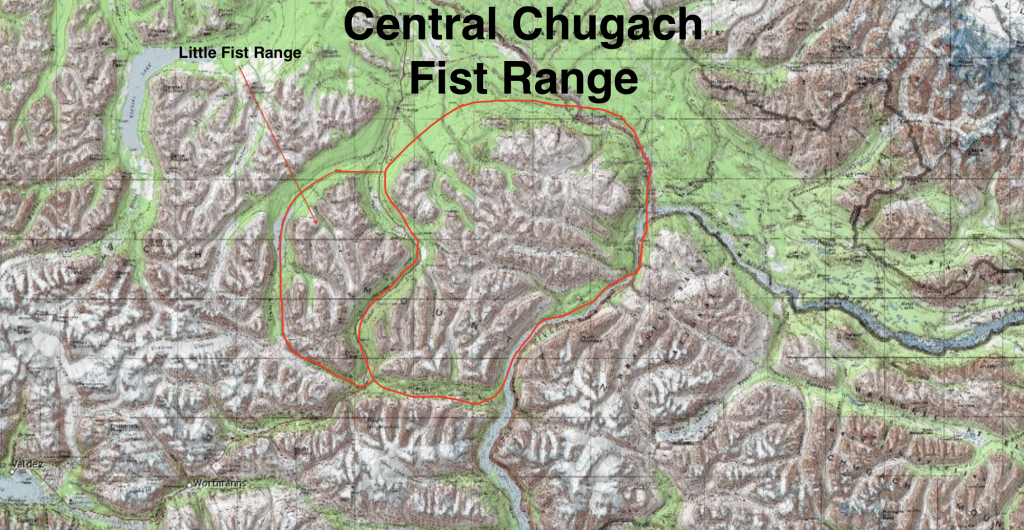
On a smoky, early July day in 2019 I climbed an obscure, but prominent (800’+), summit dubbed Jain Mountain (~6100′) in the seldom visited Little Fist subrange of the Central Chugach Mountains that exists between the Tiekel and Tonsina Rivers. This area is somewhat reminiscent of the Summit Lake area Kenai Mountains that lie west of the Seward Highway (i.e. upper Devils, Fresno, Colorado creeks). Like the Summit Lake area Kenai Mountains are to the Kenai Mountains further south, the terrain in this part of the Central Chugach (while still very rugged) is mellower than the terrain to its south.
Monkshood (aka Wolfsbane) at Boulder Creek treeline: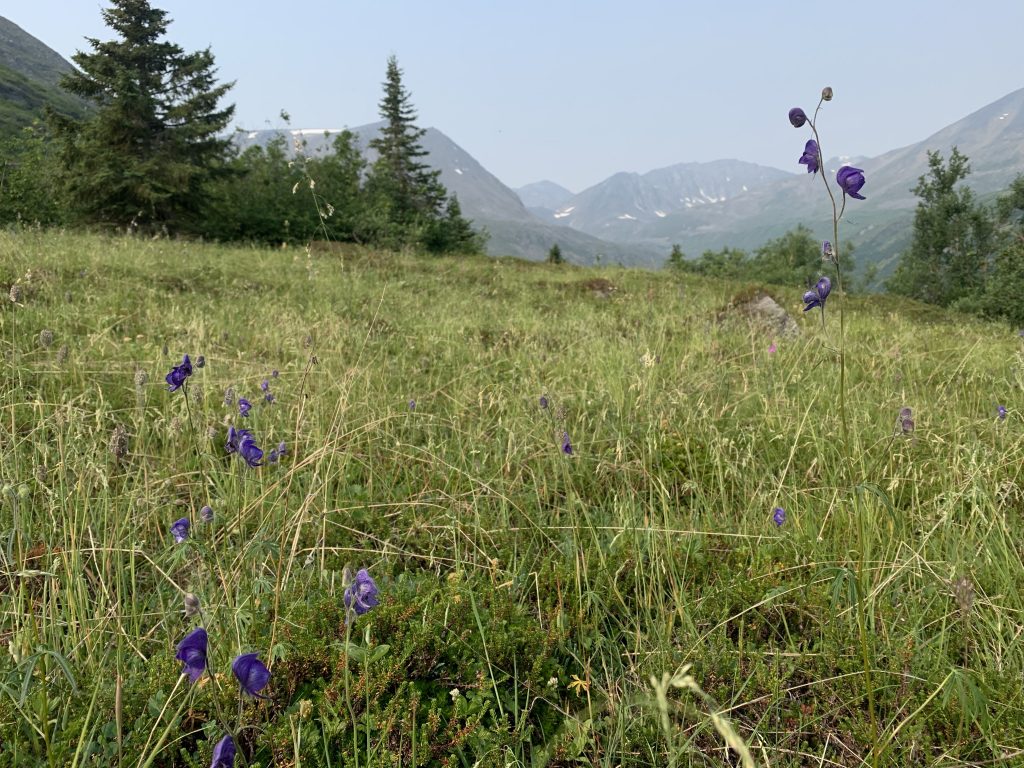
One of the many tarns up Boulder Creek on the approach: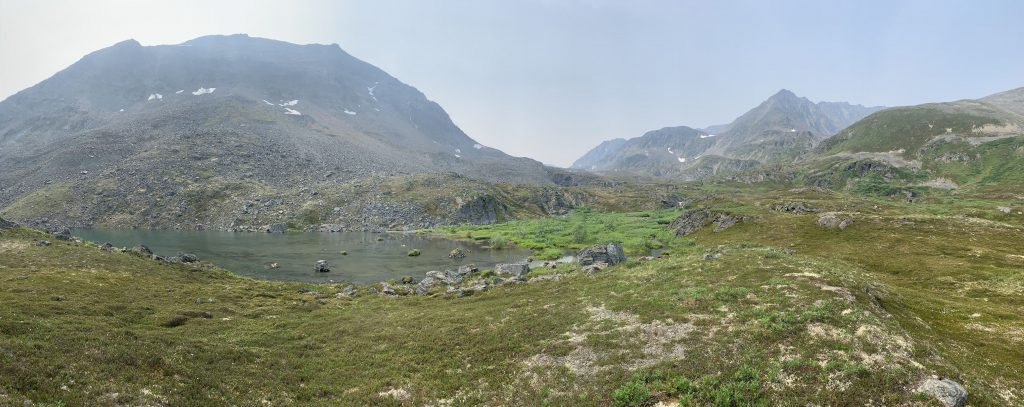
The access to this area is the same as for Mt. Tiekel and Peak 6504 (trip report here). Big thanks to Lance Breeding for maintaining the alpine access trail. To access Jain Mountain, follow the Boulder Creek trail to the alpine. Follow Lance’s cairns to the southeastern tributary of Boulder Creek around 3000′. Ford this easy to cross, but brushy, tributary. Head north and then west toward the two northwestern tributaries to Boulder Creek that bring you to upper elevation valleys west of Rice Mountain (which is identified on USGS maps). Scramble the 3rd class south ridge of Jain Mountain.
Summit view east toward Rice Mountain:
Looking south at Mt. Tiekel & Peak 6504 from Jain Mountain summit: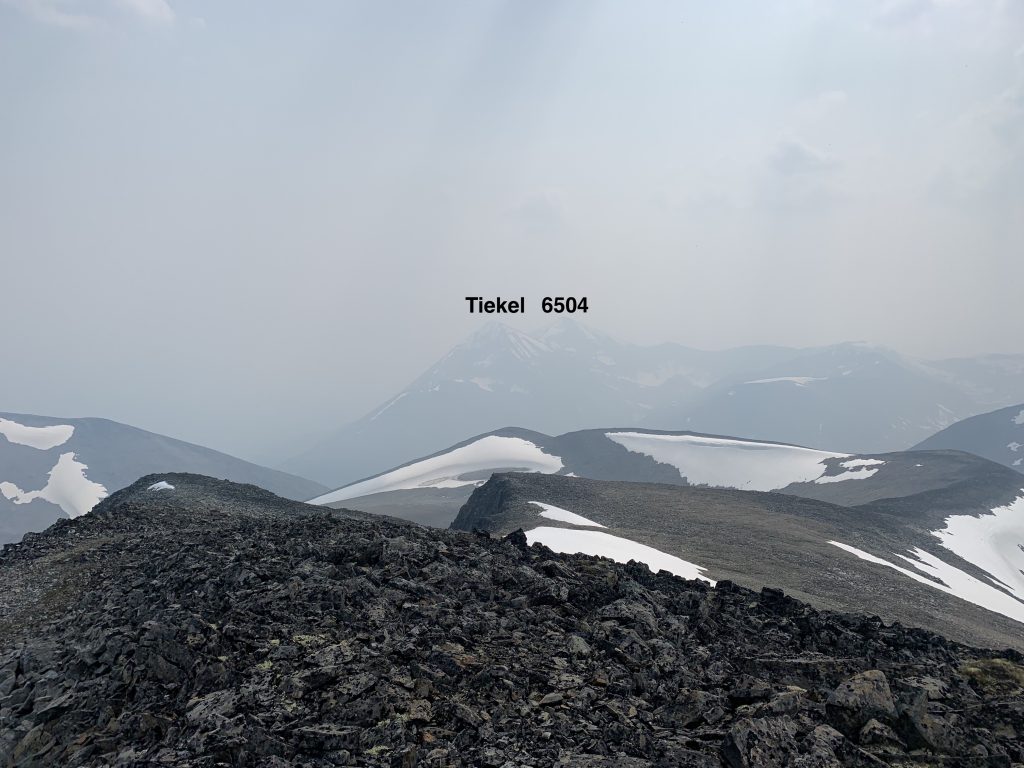
Tiekel & 6504 from the approach gully: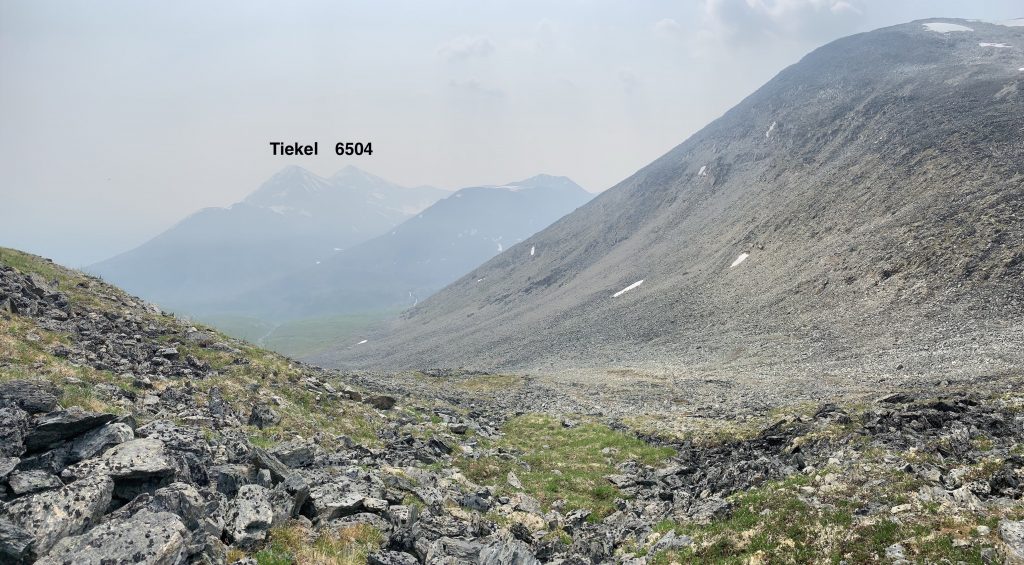

This relatively remote and seldom-visited (outside of the Valdez heli-ski season) part of the state affords limitless opportunity for exploration: backpacking, peakbagging, technical mountaineering, packrafting, etc. The neighborhood-maintained trails up Boulder and Stuart Creeks provide access to vast and relatively brush-free high-alpine Chugach terrain. While it’s public land, the locals aren’t accustomed to non-local recreational traffic. Tread lightly, be respectful and friendly, and you shouldn’t have any issues exploring this wondrous corner of The Greatland.

